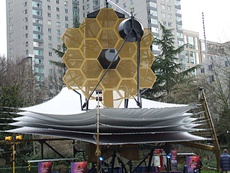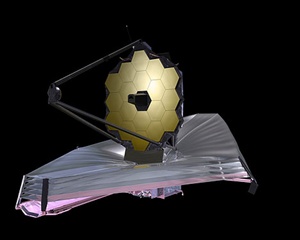Hubble successor James Webb Space Telescope set for final trials
05 Nov 2016
Twenty years ago, scientists laid out a wish list for a successor to the Hubble Space Telescope, envisioning a device that could deepen knowledge of the origins of the universe.
 On Friday, an instrument befitting that description was declared ready for its final tests at the NASA Goddard Space Flight Center.
On Friday, an instrument befitting that description was declared ready for its final tests at the NASA Goddard Space Flight Center.
The heart of the James Webb Space Telescope - a 22-foot-tall golden mirror attached to a set of four cameras and spectrographs - has been assembled inside a massive clean room on the Goddard campus.
Over the next four months, engineers will expose it to noise and violent vibrations - like those it will likely experience during a launch that's less than two years away.
The tests are the telescope's final steps at the Prince George's County installation, though a long list of preparations remains, including work to ready the Baltimore command centre that will operate it from a million miles away.
The telescope is next bound for Houston in February for more testing, Los Angeles next summer for its final assembly, then a launch pad in South America in 2018.
At an event Wednesday in Greenbelt, NASA Administrator Charles Bolden celebrated the progress at Goddard.
"This was a long time coming because it's so complex," Bolden said.
Goddard has led development of the Webb telescope since its inception in the late 1990s, while NASA chose Baltimore's Space Telescope Science Institute to oversee its scientific mission and operations in 2003.
Over that time, the $8.7-billion project has survived cost and schedule overruns and four presidential administrations to get to where it is today.
Bolden and colleagues acknowledged many technical and logistical hurdles remain but said they've learned from the travails of the Hubble, which was found to have a major flaw in its primary mirror just weeks after its launch into orbit.
The lesson: "If you really care about something, you better measure it at least twice," said John Mather, a senior astrophysicist at Goddard and the telescope's project scientist. "We built our entire project around that."
Webb was designed to see what Hubble and ground-based telescopes cannot. Its mirror is seven times the size of Hubble's, allowing it to see farther. It also can observe in infrared light. Hubble has limited ability to observe at that wavelength, and Earth's atmosphere blocks most infrared light from reaching even the most powerful mountaintop observatories.
 Scientists hope Webb will allow them to see how galaxies, planets and stars formed in the earliest days of the universe. Because light travels at a constant speed, what appears the farthest from Earth also takes the longest to get here.
Scientists hope Webb will allow them to see how galaxies, planets and stars formed in the earliest days of the universe. Because light travels at a constant speed, what appears the farthest from Earth also takes the longest to get here.
Infrared observations also could offer more illuminating views of planets outside the solar system. The telescope will detect gases such as carbon dioxide and methane more easily, and could show if a planet has enough water vapour in its atmosphere to suggest it contains oceans.
"We are opening up a whole new territory of astronomy," said Mather, who won the Nobel Prize in 2006 for work observing echoes of the Big Bang across the cosmos.
The Webb telescope's honeycomb-shaped mirror is powerful enough to spot a bee buzzing from a distance as far as the moon is from Earth, he said.
"I don't want to exaggerate, but that's beyond a miracle as far as my perspective is concerned," Mather said.
Over the next few months, the telescope will be carted out of the massive clean room inside a three-story tall tent to undergo its final tests at Goddard. It will be rattled atop platforms capable of exposing it to forces 10 times stronger than gravity, and sealed inside a sound chamber to be blasted with noise as loud as a rocket engine.
 Elements of the telescope have already gone through such tests, but engineers have to be sure the assembled apparatus can survive its ride aboard a European Space Agency rocket launching from French Guiana.
Elements of the telescope have already gone through such tests, but engineers have to be sure the assembled apparatus can survive its ride aboard a European Space Agency rocket launching from French Guiana.
"It - hopefully - is a formality," said Jason Hylan, lead mechanical engineer for the telescope's suite of instruments.
Assuming all goes well, the telescope will be shipped in February to the Johnson Space Flight Center in Houston, where it will undergo a 90-day test in frigid temperatures.
In July or August, it will move on to Northrop Grumman facilities in California, where it will take its final shape atop a silvery sun shield the size of a tennis court. All of the components will eventually be folded up to fit atop the rocket.
Once it launches, it will be six months before the telescope reaches its destination in space, and then another two weeks to unfold and prepare to begin observing sometime in 2019.
Unlike the Hubble, the Webb telescope is being placed in orbit around the sun, rather than the Earth. It will follow the Earth's path, but nearly a million miles farther from the sun.
Project leaders said they are confident that their calculations and tests will ensure a smooth journey.
Given the long path the Webb telescope has taken already, Bolden laughed when a reporter asked if the fourth presidential administration to oversee the project - that of either Donald J Trump or Hillary Clinton - could pose an unexpected threat.
Though he lamented the departure of Sen Barbara Mikulski, whom he called "a champion" for the project through her role on the Senate's Appropriations Committee, Bolden said he doesn't expect political forces to ground the telescope.
"We have an incredibly good story to tell," he said.













.jpg)






.jpg)









